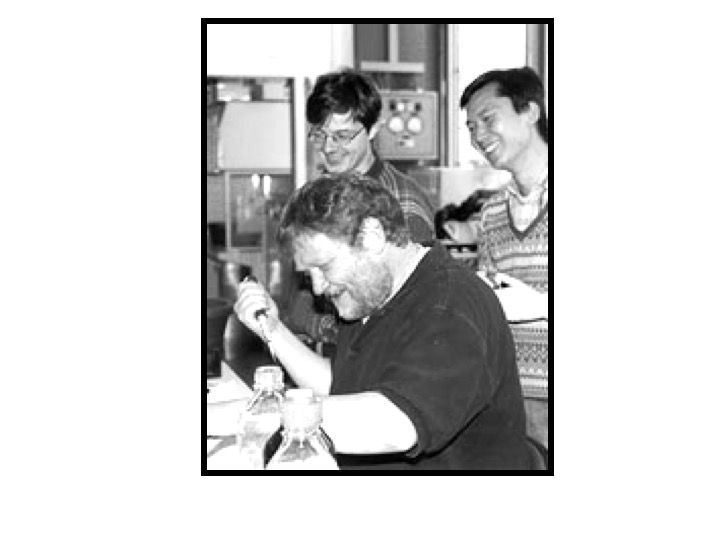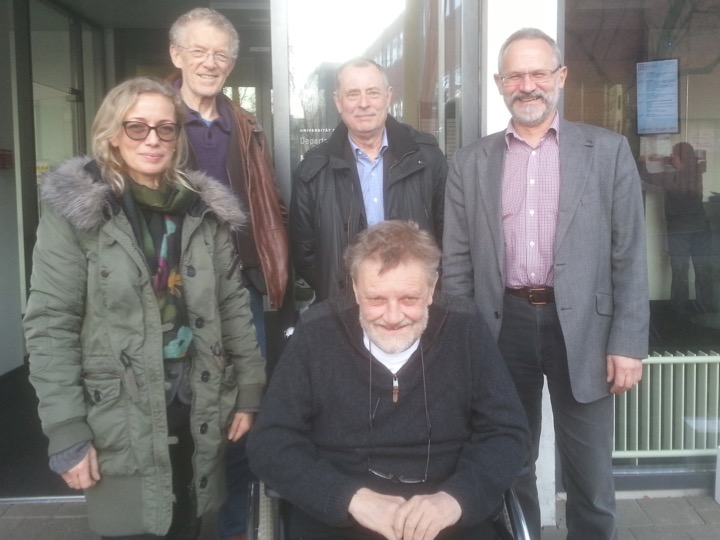
It was with shock and sadness that we learnt of the sudden death on August 13th from complications of diabetes of our Director of Research, Professor Antonius G. Rolink. Over the last two years, Ton had shown immense fortitude in overcoming the problems associated with his diabetes. Unfortunately, this had limited his ability to travel to some DECIDE meetings. However, it was with great energy, enthusiasm and considerable scientific input that he had welcomed us to Basel in early February of this year.
Ton was an outstanding research scientist who had contributed immensely to the fields of lymphocyte development and haematopoiesis. Ton started his scientific career as a T cell biologist investigating the immune pathology in a mouse model of so-called Graft versus host disease (GvHD), receiving his PhD in 1983 from the Free University of Amsterdam. In Ton’s seminal PhD thesis papers, two significant findings emerged, first, he described that there were some kinds of T cells that prevented the development of pathology. At the time these experiments were done, such cells were given the “S” word for Suppressor cells-now we know them as the “R”, or Regulatory cells. The second finding, which he continued working on, was that under the influence of T cells B cells in the host began to manufacture antibodies to self-proteins.
This original B cell question, Ton brought with him in 1984 to the Basel Institute for Immunology (BII). There he remained until the closure of the BII in 2001, becoming a permanent member in 1995. At BII, he used hybridoma technology to investigate the specificity of anti-self antibodies arising in GvHD. This work at BII on the origin of anti-self antibodies then initiated a whole series of experiments to investigate the development of mouse B cells in more detail. In particular, using monoclonal antibodies to cell surface determinants and flow cytometry, this involved deciphering how and in which cell the mouse B cell receptor was initially pieced together and expressed. In addition, the generation of B cells was quantified as well as the kinetics of their production and loss. In summary, this information threw fresh light on how self/non-self discrimination of B cells was achieved.
In order to carry out these studies at the single cell level, Ton developed culture systems using “feeder”, or stromal, cells that allowed the cloning of B cells at an early stage in their development, when they had not yet expressed their receptors. These cells are called B cell progenitors. For this culturing work, addition of soluble factors, called cytokines, was necessary and one important cytokine for this was Interleukin-7. With collections of different stromal cells and cytokines, conditions were developed supporting the development of many different lineages of bone marrow cells as well as mature B cells. In addition, using emerging molecular biological techniques, individual B cells were also being analysed at the molecular level. The precision by which this was being done was extraordinary, to the extent that one molecule of rearranged DNA could be detected in individual cells thereby accurately mapping the sequence of B cell receptor gene rearrangements.
It is true to say that Ton’s group at BII became world leaders in the study of mouse and human B cell development. All this work opened up new fields of research leading to a much better understanding of normal B cell development, information that could also be applied to situations of abnormal B cell development such as leukaemia. The massive impact of all this work on immunology cannot be ignored. As a consequence, Ton’s opinion and expertise was in high demand and resulted in many important collaborations.
Ton’s skill in the laboratory was legendary. Ton had “Green fingers” when it came to growing cells in a dish and was a “Lymphocyte gardener” and could make all kinds of cells grow. The two Nature papers of October 7th 1999 describing the Pax5 knock out pro B cells and their development in vitro into an antigen-presenting dendritic cell, a bacterium-engulfing macrophage, a bone-resorbing osteoclast, a bactericidal granulocyte or a natural killer cell and then the in vivo reconstitution of T cells, represent a tour de force of cell and lymphocyte biology. Thus Pax5 deficient pro B cells revealed multi-lineage potentiality, a finding difficult to reconcile with the then current models of haematopoiesis.
In 2001, Ton was appointed Roche Professor of Immunology at the University of Basel and moved to laboratories initially at the Biozentrum, then to the Department of Biomedicine in Mattenstrase. Research was focussed on identifying a progenitor cell in normal mice having multi-lineage potential similar to the Pax5 deficient cells. After considerable efforts, a population of similar phenotype (B220+,c-kitlow, CD19-, NK1.1-) with multi-lineage potential was indeed found and called Early Progenitor with Lymphoid and Myeloid Potential (EPLM). Recent work carried out by the DECIDE consortium has shown that EPLM contain at least four phenotypically and genotypically distinct subpopulations.
Having developed his stromal cell-based culture systems, Ton was intrigued by the emerging technique of using stromal cells to also grow T cell progenitors. Therefore, he again focussed his attention on T cells. With his critical eye, he realised that there were deficiencies in the culture system being used and for many years, Ton and his laboratory worked on developing an alternative culture system completely free of stromal cells using recombinant proteins only. This they have done and the system is affectionately called “the plastic thymus”.
Using cells grown with such a system, it was now possible to reconstitute mice with cultured and genetically-modified T cell progenitors. However, the phenomenon of autoimmunity, initially observed during his PhD, was again encountered. This time there was T cell autoimmunity due to a lack of regulatory T cells in the host and autoantibodies developed from B cells. Very recently, the laboratory has been able to show that there are two possible origins of such “bad” B cells in GvHD. The first is that they are generated with an already self-reactive receptor which then mutates to recognise self-molecules more avidly. The second is that they develop from cells which initially recognised a non-self antigen but which then mutate to now recognise self.
Therefore, in some ways, Ton’s scientific career went full circle.
As a scientist and teacher, there are many features that characterise our colleague “Ton”. The first of these was his hard work - he worked long hours. Ton was the consummate experimentalist maintaining absolute and constant passion for his science until very shortly before his death. Most visitors were surprised when they saw an eminent senior research scientist actually at the bench culturing, staining or analysing cells, handling mice or operating a cell sorter!
One of Ton’s greatest attributes was his scientific generosity; the sharing of ideas is a rare quality among scientists. As a university Professor, Ton was an inspirational teacher presenting immunology in the most-simple way. Ton’s sense of humour was all pervasive. Who can forget conversations with Ton about almost any topic - they were full of laughter and amusing anecdotes.
As well as his numerous publications, Ton’s legacy is having mentored a whole generation of scientists whose careers were either started, or influenced by his work. This includes the two DECIDE ESR’s lucky enough to have been working in Ton’s laboratory.
For the DECIDE consortium, Ton was its Director of Research and he fulfilled this role with his inimitable energy and scientific rigour. All ESR’s were always most appreciative of his comments and suggestions regarding their projects. He was a genuine “Doktorvater” or scientific father of ESR’s.
It is still difficult to believe that we will no longer hear Ton’s voice.

Posted on Monday 21st August 2017